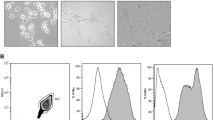Abstract.
Alzheimer's disease (AD) is characterized by the massive deposition in the brain of the 40–42-residue amyloid β protein (Aβ). While Aβ1–40 predominates in the vascular system, Aβ1–42 is the major component of the senile plaques in the neuropil. The concentration of both Aβ species required to form amyloid fibrils in vitro is micromolar, yet soluble Aβs found in normal and AD brains are in the low nanomolar range. It has been recently proposed that the levels of Aβ sufficient to trigger amyloidogenesis may be reached intracellularly. To study the internalization and intracellular accumulation of the major isoforms of Aβ, we used THP-1 and IMR-32 neuroblastoma cells as models of human monocytic and/or macrophagic and neuronal lineages, respectively. We tested whether these cells were able to internalize and accumulate 125I-Aβ1–40 and 125I-Aβ1–42 differentially when offered at nanomolar concentrations and free of large aggregates, conditions that mimic a prefibrillar stage of Aβ in AD brain. Our results showed that THP-1 monocytic cells internalized at least 10 times more 125I-Aβs than IMR-32 neuroblastoma cells, either isolated or in a coculture system. Moreover, 125I-Aβ1–42 presented a higher adsorption, internalization, and accumulation of undigested peptide inside cells, as opposed to 125I-Aβ1–40. These results support that Aβ1–42, the major pathogenic form in AD, may reach supersaturation and generate competent nuclei for amyloid fibril formation intracellularly. In light of the recently reported strong neurotoxicity of soluble, nonfibrillar Aβ1–42, we propose that intracellular amyloidogenesis in microglia is a protective mechanism that may delay neurodegeneration at early stages of the disease.
Similar content being viewed by others
Author information
Authors and Affiliations
Additional information
Electronic Publication
Rights and permissions
About this article
Cite this article
Morelli, L., Prat, M. & Castaño, E. Differential accumulation of soluble amyloid β peptides 1–40 and 1–42 in human monocytic and neuroblastoma cell lines. Cell Tissue Res 298, 225–232 (1999). https://doi.org/10.1007/s004419900109
Received:
Accepted:
Issue Date:
DOI: https://doi.org/10.1007/s004419900109




